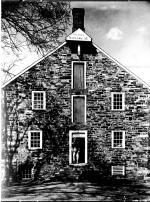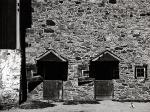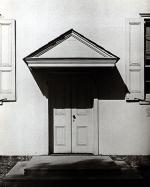![header=[Marker Text] body=[A major 20th century photographer, Siskind did architectural images of Bucks County between 1939 and 1945 and influenced the development of American art photography. His work was at a period of transition from a "documentary" style to a more radical abstract style that set the standard in serious art photography for the next 30 years.] sign](http://explorepahistory.com/kora/files/1/10/1-A-19F-139-ExplorePAHistory-a0a9s4-a_450.gif)
Mouse over for marker text
Name:
Aaron Siskind
Region:
Philadelphia and its Countryside/Lehigh Valley
County:
Bucks
Marker Location:
28 E. Swamp Rd. (Pa. 313) east of Pa. 611, Doylestown (Cross Keys)
Dedication Date:
October 29, 2004
Behind the Marker
Photographer Aaron Siskind never would have come to Bucks County had not Charlotte Stryker commissioned him, in 1934, to photograph a book illustrating the old houses of Bucks County. Stryker never finished the book, but Siskind's experience in Pennsylvania, however brief, had an important effect both on his own art and on the history of photography.
For the rest of his career, influenced by the drawings and photographs of Charles Sheeler, who came from the same area, Siskind became one of the most influential photographers of the twentieth century. Critic Eby Lloyd called him "the father of modern photography. His work, more than that of any single photographer, has freed photography from its concerns with simple representation, documentation, or portraiture, and has taken it to the realm of poetic signification. In Siskind's hands, photography attained its potential as a full abstract and expressionist art."
Charles Sheeler, who came from the same area, Siskind became one of the most influential photographers of the twentieth century. Critic Eby Lloyd called him "the father of modern photography. His work, more than that of any single photographer, has freed photography from its concerns with simple representation, documentation, or portraiture, and has taken it to the realm of poetic signification. In Siskind's hands, photography attained its potential as a full abstract and expressionist art."
Siskind's artistic turning point occurred in an old, tranquil, rural setting where artists had been seeking inspiration for more than three decades. Artists' colonies began to spring up in the United States in the late nineteenth century. Much as the rich escaped the hustle and bustle of urban life for Newport, Rhode Island, or St. Augustine, Florida, and Teddy Roosevelt inspired easterners to flock West to dude ranches, artists flocked to Woodstock or East Hampton, New York, Provincetown and Gloucester, Massachusetts, Taos, New Mexico, and Carmel-Monterey or Santa Barbara, California (the latter the final home of Pennsylvanian Thomas Moran).
Although Howard Pyle founded a summer school in Chadds Ford that lasted from 1898 to 1903, and the Pennsylvania Academy of Fine Arts sponsored a rural summer school at
Pennsylvania Academy of Fine Arts sponsored a rural summer school at  Chester Springs from 1916 to 1952, Bucks County - especially the area around New Hope on the Delaware River - was Pennsylvania's principal artist colony. Beginning around 1900, artists began to cluster around the rustic house of painter William Lathrop, an old mill first constructed in 1756. Daniel Garber and Edward Redfield were the most famous painters associated with New Hope, although Redfield was a reclusive man who lived in a house on the Delaware Canal, "a place where an independent self-sufficient man could make a living from the land, bring up a family, and still have the freedom to paint as he saw fit."
Chester Springs from 1916 to 1952, Bucks County - especially the area around New Hope on the Delaware River - was Pennsylvania's principal artist colony. Beginning around 1900, artists began to cluster around the rustic house of painter William Lathrop, an old mill first constructed in 1756. Daniel Garber and Edward Redfield were the most famous painters associated with New Hope, although Redfield was a reclusive man who lived in a house on the Delaware Canal, "a place where an independent self-sufficient man could make a living from the land, bring up a family, and still have the freedom to paint as he saw fit."
The County seat of Doylestown also became another center of art anchored by the home of Henry Chapman Mercer, a friend of many artists, and later in the twentieth century by the popular author James Michener, who donated several million dollars towards the creation of James Michener Art Museum, which houses a superb collection of Pennsylvania regional painters.
Henry Chapman Mercer, a friend of many artists, and later in the twentieth century by the popular author James Michener, who donated several million dollars towards the creation of James Michener Art Museum, which houses a superb collection of Pennsylvania regional painters.
Before Siskind's Pennsylvania trip, he had made a name for himself as a socially concerned, activist photographer. Although his technique was not yet original, his meteoric rise to photographic fame was no small achievement for the son of Russian Jewish immigrants, who received his first camera as a wedding gift in 1929. Born in New York City in 1903, Siskind graduated from the City College of New York in 1926 and then taught English in the city public schools for the next twenty years. Beginning in the early 1930s, however, photography became his passion. His earliest works are striking close ups of small objects or body parts which depend on lighting and perspective for their effects.
Between 1932 and 1941 Siskind was active in the New York Workers' Film and Photo League, organized by the Communist Party to depict the sufferings of people under capitalism. Among his memorable works from this period were "The Harlem Document" - some 300 works now owned by the George Eastman House in Rochester, New York - "The Most Crowded Block in the World," "Dead End," and "The Bowery." Following his trip to Pennsylvania, however, Siskind became more interested in photography as an art form and less interested in politics. "When I make a photograph I want it to be an altogether new object, complete and self-contained, whose basic condition is order," he wrote. "My pictures are ambiguous. I'll photograph a thing as it is, more or less. . . . but then you look at it and realize it doesn't mean that, it means something else." Close-ups of garbage, the rocks at Martha's Vineyard and Gloucester, Massachusetts (where he spent his summer), graffiti, or parts of buildings were among his favorite subjects. Siskind's work showed that anything, with the proper lighting and perspective, could be a beautiful object when photographed.
In the post-war years, Siskind continued to live in New York where he became friends with Abstract Expressionist artists such as Franz Kline, Willem de Kooning and Mark Rothko. They acknowledged that Siskind's photographs were an important influence on their work; he, in turn, learned from them. One of his most important series of images is "Homage to Franz Kline." In 1947, he resigned from the city schools and subsequently taught art at Trenton Junior College in New Jersey and Black Mountain College in North Carolina.
Franz Kline, Willem de Kooning and Mark Rothko. They acknowledged that Siskind's photographs were an important influence on their work; he, in turn, learned from them. One of his most important series of images is "Homage to Franz Kline." In 1947, he resigned from the city schools and subsequently taught art at Trenton Junior College in New Jersey and Black Mountain College in North Carolina.
His most important posts were at the Illinois Institute of Technology in Chicago from 1951 to 1971, and at the Rhode Island School of Design in Providence from 1971 to 1976.
Students remember him as an effective and encouraging teacher who did not force them to follow his style. Siskind's most important later works included pictures from his travels to Greece, Rome, and South America, and "Terrors and Pleasures of Levitation," which examines the expression and body language of divers in mid-air. Shortly before his death, Siskind established a foundation to promote the study and practice of photography as an art.
For the rest of his career, influenced by the drawings and photographs of
Siskind's artistic turning point occurred in an old, tranquil, rural setting where artists had been seeking inspiration for more than three decades. Artists' colonies began to spring up in the United States in the late nineteenth century. Much as the rich escaped the hustle and bustle of urban life for Newport, Rhode Island, or St. Augustine, Florida, and Teddy Roosevelt inspired easterners to flock West to dude ranches, artists flocked to Woodstock or East Hampton, New York, Provincetown and Gloucester, Massachusetts, Taos, New Mexico, and Carmel-Monterey or Santa Barbara, California (the latter the final home of Pennsylvanian Thomas Moran).
Although Howard Pyle founded a summer school in Chadds Ford that lasted from 1898 to 1903, and the
The County seat of Doylestown also became another center of art anchored by the home of
Before Siskind's Pennsylvania trip, he had made a name for himself as a socially concerned, activist photographer. Although his technique was not yet original, his meteoric rise to photographic fame was no small achievement for the son of Russian Jewish immigrants, who received his first camera as a wedding gift in 1929. Born in New York City in 1903, Siskind graduated from the City College of New York in 1926 and then taught English in the city public schools for the next twenty years. Beginning in the early 1930s, however, photography became his passion. His earliest works are striking close ups of small objects or body parts which depend on lighting and perspective for their effects.
Between 1932 and 1941 Siskind was active in the New York Workers' Film and Photo League, organized by the Communist Party to depict the sufferings of people under capitalism. Among his memorable works from this period were "The Harlem Document" - some 300 works now owned by the George Eastman House in Rochester, New York - "The Most Crowded Block in the World," "Dead End," and "The Bowery." Following his trip to Pennsylvania, however, Siskind became more interested in photography as an art form and less interested in politics. "When I make a photograph I want it to be an altogether new object, complete and self-contained, whose basic condition is order," he wrote. "My pictures are ambiguous. I'll photograph a thing as it is, more or less. . . . but then you look at it and realize it doesn't mean that, it means something else." Close-ups of garbage, the rocks at Martha's Vineyard and Gloucester, Massachusetts (where he spent his summer), graffiti, or parts of buildings were among his favorite subjects. Siskind's work showed that anything, with the proper lighting and perspective, could be a beautiful object when photographed.
In the post-war years, Siskind continued to live in New York where he became friends with Abstract Expressionist artists such as
His most important posts were at the Illinois Institute of Technology in Chicago from 1951 to 1971, and at the Rhode Island School of Design in Providence from 1971 to 1976.
Students remember him as an effective and encouraging teacher who did not force them to follow his style. Siskind's most important later works included pictures from his travels to Greece, Rome, and South America, and "Terrors and Pleasures of Levitation," which examines the expression and body language of divers in mid-air. Shortly before his death, Siskind established a foundation to promote the study and practice of photography as an art.







